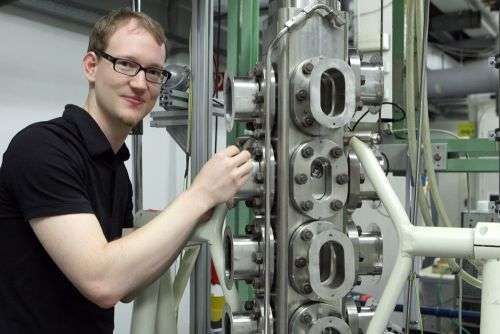How new substances form

Gas bubbles rise in a liquid. What looks like a bottle of sparkling mineral water actually is a type of reactor frequently used in industry – a bubble column. These reactors are found in laboratories and large technology towers at almost any chemical plant. New compounds, created at the bubble's boundary layers, are the raw materials for numerous objects of our everyday life. Developing ways to control these processes and to optimize them is therefore of large interest. In the framework of the
Collaborative Research Center (SFB 716), scientists from the Institute of Chemical Process Engineering at the University of Stuttgart work on exactly this topic. They develop computer simulations to test relevant factors.
Inside of a bubble column, gas bubbles rise in a liquid. While this happens, chemical processes take place at their outer layers where different substances are in contact. About 90 percent of all products of the chemical industry are generated in this way. These products are ultimately incorporated into a variety of goods such as cosmetics, clothing, plastic items (bottles, garbage bags, foils), as well as synthetic fuels, such as those used for the propulsion of ships or missiles.
Simulations are one way to better understand and optimize the process of formation of those chemical products. So far, scientists mostly modeled the circulation of gas bubbles and the induced fluid flow, using computer simulations. However, this approach only allows for limited predictions about varying process conditions.
This could be changed by particle simulations, which were developed at the Collaborative Research Center (SFB 716) focusing on "Dynamic Simulations of Systems with Large Numbers of Particles" at the University of Stuttgart. The research team led by Prof. Dr.-Ing. Ulrich Nieken at the Institute of Chemical Engineering concentrates its research efforts on the boundary layers of the gas bubbles, since this is where the actual chemical reactions take place.
The researchers develop computer simulations to test relevant factors such as column size, quantities of liquid, or different combinations of substances. By means of these simulations, they want to clarify important details like: Under what conditions do the desired reactions occur? What chemical phenomena play a role? What quantity of the final product can be produced, and how can these processes be accelerated to optimize throughput?
To achieve this, the researchers develop complex numerical calculation schemes for which they utilize high performance computer clusters or graphics cards. The methods developed by the scientists of the SFB are cutting edge in simulations of the described processes.
The current research results were published in July as part of a special issue of the journal Chemie Ingenieur Technik on bubble columns. Chemie Ingenieur Technik is the most important German-language magazine for process engineers, technical chemists, apparatus engineers, and biotechnologists.
Provided by University of Stuttgart


















